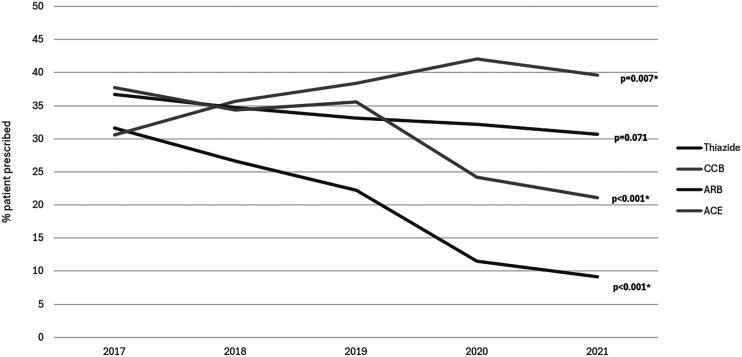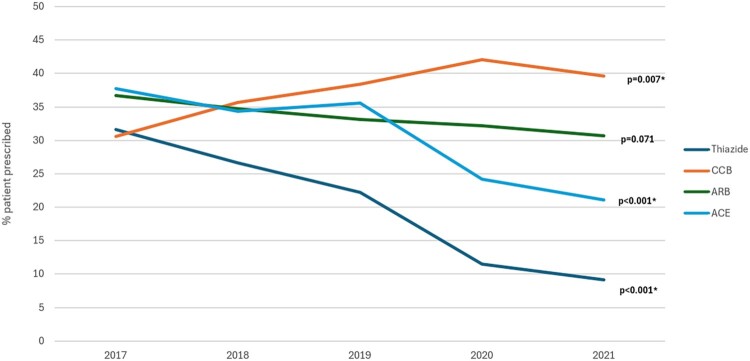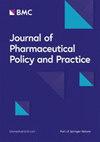Nada Nabil Abdelkader, Ahmed Awaisu, Hazem Elewa, Ziyad Mahfoud, Samya Ahmad Al Abdulla, Amjad Owais, Maguy Saffouh El Hajj
下载PDF
{"title":"卡塔尔初级卫生保健机构抗高血压药物的处方趋势和模式:一项回顾性观察性研究","authors":"Nada Nabil Abdelkader, Ahmed Awaisu, Hazem Elewa, Ziyad Mahfoud, Samya Ahmad Al Abdulla, Amjad Owais, Maguy Saffouh El Hajj","doi":"10.1080/20523211.2025.2512183","DOIUrl":null,"url":null,"abstract":"<p><strong>Background: </strong>An observational retrospective study was conducted in the primary care setting in Qatar to evaluate the prescribing trends and patterns of antihypertensives in hypertensive patients.</p><p><strong>Methods: </strong>Included patients were adult patients (aged ≥18 years) diagnosed with essential hypertension and attending Primary Health Care Corporation (PHCC) clinics in Qatar between January 2017 and March 2021. A sample of 2185 patients was randomly selected. The data were collected from PHCC's electronic medical records system, Cerner©.</p><p><strong>Results: </strong>Angiotensin Converting Enzyme inhibitors (ACEIs) prescriptions decreased from 38% in 2017 to 21% in 2021, and that of Angiotensin Receptor Blockers (ARBs) from 37% in 2017 to 31% in 2021. Patients with prescribed Calcium Channel Blockers (CCBs) increased from 31% in 2017 to 40% in 2021. The prescribing of thiazide diuretics declined from 32% in 2017 to 9% in 2021. In 2017, the most prescribed antihypertensive class was ACEIs (38%), while the least prescribed antihypertensive class was loop diuretics (1.4%). In 2018, the most prescribed class of antihypertensives was CCBs (36%) and the least prescribed was vasodilators (0.1%). In 2019, 2020 and 2021, CCBs were the most prescribed.</p><p><strong>Conclusion: </strong>These findings are consistent with national and international guidelines for hypertension management and with published literature. Yet, there is still room for improvement to optimise antihypertensive prescribing practices. Prescribers need to address potential gaps and explore ways to enhance their hypertension management, so that patients have access to effective and evidence-based treatments.</p>","PeriodicalId":16740,"journal":{"name":"Journal of Pharmaceutical Policy and Practice","volume":"18 1","pages":"2512183"},"PeriodicalIF":2.5000,"publicationDate":"2025-06-18","publicationTypes":"Journal Article","fieldsOfStudy":null,"isOpenAccess":false,"openAccessPdf":"https://www.ncbi.nlm.nih.gov/pmc/articles/PMC12180352/pdf/","citationCount":"0","resultStr":"{\"title\":\"Prescribing trends and patterns for antihypertensive agents in primary healthcare settings in Qatar: a retrospective observational study.\",\"authors\":\"Nada Nabil Abdelkader, Ahmed Awaisu, Hazem Elewa, Ziyad Mahfoud, Samya Ahmad Al Abdulla, Amjad Owais, Maguy Saffouh El Hajj\",\"doi\":\"10.1080/20523211.2025.2512183\",\"DOIUrl\":null,\"url\":null,\"abstract\":\"<p><strong>Background: </strong>An observational retrospective study was conducted in the primary care setting in Qatar to evaluate the prescribing trends and patterns of antihypertensives in hypertensive patients.</p><p><strong>Methods: </strong>Included patients were adult patients (aged ≥18 years) diagnosed with essential hypertension and attending Primary Health Care Corporation (PHCC) clinics in Qatar between January 2017 and March 2021. A sample of 2185 patients was randomly selected. The data were collected from PHCC's electronic medical records system, Cerner©.</p><p><strong>Results: </strong>Angiotensin Converting Enzyme inhibitors (ACEIs) prescriptions decreased from 38% in 2017 to 21% in 2021, and that of Angiotensin Receptor Blockers (ARBs) from 37% in 2017 to 31% in 2021. Patients with prescribed Calcium Channel Blockers (CCBs) increased from 31% in 2017 to 40% in 2021. The prescribing of thiazide diuretics declined from 32% in 2017 to 9% in 2021. In 2017, the most prescribed antihypertensive class was ACEIs (38%), while the least prescribed antihypertensive class was loop diuretics (1.4%). In 2018, the most prescribed class of antihypertensives was CCBs (36%) and the least prescribed was vasodilators (0.1%). In 2019, 2020 and 2021, CCBs were the most prescribed.</p><p><strong>Conclusion: </strong>These findings are consistent with national and international guidelines for hypertension management and with published literature. Yet, there is still room for improvement to optimise antihypertensive prescribing practices. Prescribers need to address potential gaps and explore ways to enhance their hypertension management, so that patients have access to effective and evidence-based treatments.</p>\",\"PeriodicalId\":16740,\"journal\":{\"name\":\"Journal of Pharmaceutical Policy and Practice\",\"volume\":\"18 1\",\"pages\":\"2512183\"},\"PeriodicalIF\":2.5000,\"publicationDate\":\"2025-06-18\",\"publicationTypes\":\"Journal Article\",\"fieldsOfStudy\":null,\"isOpenAccess\":false,\"openAccessPdf\":\"https://www.ncbi.nlm.nih.gov/pmc/articles/PMC12180352/pdf/\",\"citationCount\":\"0\",\"resultStr\":null,\"platform\":\"Semanticscholar\",\"paperid\":null,\"PeriodicalName\":\"Journal of Pharmaceutical Policy and Practice\",\"FirstCategoryId\":\"1085\",\"ListUrlMain\":\"https://doi.org/10.1080/20523211.2025.2512183\",\"RegionNum\":0,\"RegionCategory\":null,\"ArticlePicture\":[],\"TitleCN\":null,\"AbstractTextCN\":null,\"PMCID\":null,\"EPubDate\":\"2025/1/1 0:00:00\",\"PubModel\":\"eCollection\",\"JCR\":\"Q1\",\"JCRName\":\"HEALTH POLICY & SERVICES\",\"Score\":null,\"Total\":0}","platform":"Semanticscholar","paperid":null,"PeriodicalName":"Journal of Pharmaceutical Policy and Practice","FirstCategoryId":"1085","ListUrlMain":"https://doi.org/10.1080/20523211.2025.2512183","RegionNum":0,"RegionCategory":null,"ArticlePicture":[],"TitleCN":null,"AbstractTextCN":null,"PMCID":null,"EPubDate":"2025/1/1 0:00:00","PubModel":"eCollection","JCR":"Q1","JCRName":"HEALTH POLICY & SERVICES","Score":null,"Total":0}
引用次数: 0
引用
批量引用
Prescribing trends and patterns for antihypertensive agents in primary healthcare settings in Qatar: a retrospective observational study.
Background: An observational retrospective study was conducted in the primary care setting in Qatar to evaluate the prescribing trends and patterns of antihypertensives in hypertensive patients.
Methods: Included patients were adult patients (aged ≥18 years) diagnosed with essential hypertension and attending Primary Health Care Corporation (PHCC) clinics in Qatar between January 2017 and March 2021. A sample of 2185 patients was randomly selected. The data were collected from PHCC's electronic medical records system, Cerner©.
Results: Angiotensin Converting Enzyme inhibitors (ACEIs) prescriptions decreased from 38% in 2017 to 21% in 2021, and that of Angiotensin Receptor Blockers (ARBs) from 37% in 2017 to 31% in 2021. Patients with prescribed Calcium Channel Blockers (CCBs) increased from 31% in 2017 to 40% in 2021. The prescribing of thiazide diuretics declined from 32% in 2017 to 9% in 2021. In 2017, the most prescribed antihypertensive class was ACEIs (38%), while the least prescribed antihypertensive class was loop diuretics (1.4%). In 2018, the most prescribed class of antihypertensives was CCBs (36%) and the least prescribed was vasodilators (0.1%). In 2019, 2020 and 2021, CCBs were the most prescribed.
Conclusion: These findings are consistent with national and international guidelines for hypertension management and with published literature. Yet, there is still room for improvement to optimise antihypertensive prescribing practices. Prescribers need to address potential gaps and explore ways to enhance their hypertension management, so that patients have access to effective and evidence-based treatments.



 求助内容:
求助内容: 应助结果提醒方式:
应助结果提醒方式:


